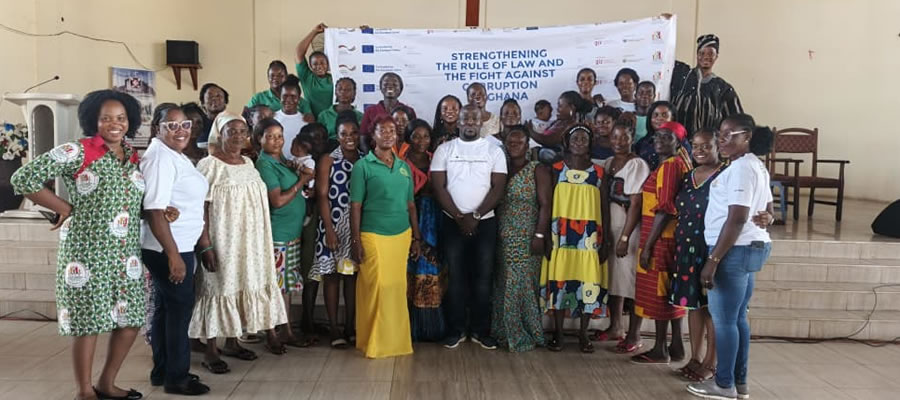

The Ningo-Prampram district is largely rural. The predominance of rural population reflects in the occupational distribution with agriculture as the dominant occupation. About 90 percent of the total land area is arable land and about 25 percent is mainly savannah grassland suitable for livestock farming. The major crops grown in the district are cassava, maize, mango, banana, vegetables (tomato, okro, pepper) and rice. The district border on the Gulf of Guinea with a coastline stretching over 37 kilometers gives the district vast fishing potential. This potential is currently under great exploitation by many households in the district.
Irrigation agriculture is practiced on a medium scale in the district. About 15.6 percent of crop farmers are engaged in irrigation agriculture under the Dawhenya Irrigation Scheme with the remaining depending on rain (rain fed agriculture). The total land area at the scheme site is 480 hectares. Currently, the developed area of the scheme is 240 hectares. The main Irrigation Scheme has reservoir with a capacity of 5.6 million cubic meters of water for irrigation. The farmers have organized themselves into co-operative societies which are registered under the Department of Co - operatives.
There are a number of manufacturing activities in the district that provide employment opportunities for the people. The activities cover production of agricultural inputs (e.g. RANNAH Fish Feed Company), carpentry (e.g. MELGREP Company), block making companies and small scale aluminium industries that produce cooking utensils.
Although agriculture dominates in the district, the leading sectors in terms of revenue to the district Assembly and remunerations to workers is the housing development sector. Financial reports from the District Assembly indicate that the highest contribution to internally generated revenue comes from building permit applications and fines. This is followed closely by business operating permits.
The economic characteristic of population is important for development planning and other purposes. They are also development indicators to determine how government is able to manage the population and national resources in order to provide the needs of the population and thereby achieve the human development goals.
The economic characteristics of a population also help in examining population and development interventions so that appropriate policies can be adopted. Population and development policies have been a major area of research and policy concern in developing countries, including Ghana and for that matter Ningo-Prampram district. It is against this background that the economic characteristics of the population of Ningo-Prampram district are discussed in this chapter. The areas of focus include economic activity status, employment status and sector, occupation and industry.
Economic Activity Status
Data on economic activity were collected from persons 15 years and older who worked for pay (cash or kind), profit or family gain during the seven days preceding the census night. Table 4.1 and Figure 4.1 show the economic activity status by sex of the population in Ningo-Prampram District. About 66.8 percent of the population are economically active and the remaining 33.2 percent are economically not active. About 94.1 percent of the economically active population are employed and 5.9 percent are unemployed.
Among the male population, 69.4 percent are economically active and 30.6 percent are not active compared to 64.7 percent and 35.3 percent, respectively, among the female population. Among the male economically active population, 95.0 percent are employed and 5.0 percent are unemployed compared to 93.3 percent and 6.7 percent, respectively, among the female economically active population.
Economic activity status by age and sex
Table 4.2 shows the economic activity status of population 15 years and older by age and sex in the district in 2010. The proportion of the employed economically active population by age group increases steadily from 20.6 percent among the 15.19 years age group to 88.0 percent among the 40-44 years age group and declines also steadily to 46.8 percent among the 65+ years age group.
Among the economically active male population, the proportion employed increases steadily from 22.1 percent among the 15-19 years age group to 92.1 percent among the 40-44 years age group and declines to 52.4 percent among the 65+ years age group. The trend in proportions among the economically active employed females is similar to that of males except that the proportion peaks at 85.3 percent among the 45-49 years age group.
Occupation
Occupation refers to the type of work a person is engaged in at the establishment where he/she works. In the census, this was asked of persons who worked for at least one hour during the seven days before the census night, and those who did not work but had a job to return to as well as those who were unemployed but had worked before.
All persons who worked during the seven days before the census night were classified by the kind of work they engaged in. The emphasis was on the work the person did during the reference period.
Table 4.3 shows the employed population by occupation in Ningo-Prampram district. The highest proportion of the employed population are skilled agricultural, forestry and fishery 40 workers (28.5%), followed by service and sales 24.0 percent, craft and related trades (21.8%) and other occupations accounted for the remaining 0.7 percent.
There are more males (36.2%) in skilled agricultural, forestry and fishery occupations than their female counterparts (21.4%). On the other hand, a higher proportion of females (37.8%) than males (9.0%) are in service and sales occupation. Among the employed females, 3.0 percent are managers compared to 2.7 percent among the employed males.
Employment Status
Employment status refers to the position of a person in the establishment where he/she currently works or previously worked. Eight employment status categories were provided in the 2010 PHC: employee, self-employed without employees, self-employed with employees, casual worker, contributing family worker, apprentice and domestic employee (house-help).
Table 4.5 show employment status of employed population 15 years and older in the district. The self–employed without employees accounts for the highest proportion (62.4%) of the employed population, followed by employees (21.5%), contributing family workers (6.0%) and self-employed with employee/s (4.8%). Higher proportions among employed females are self-employed without employees (73.7%) and contributing family workers (7.0%) compared to their male counterparts (50.3% and 4.9%, respectively), Higher proportions among employed males are employees (32.7%), casual workers (3.4%) and self-employed with employee/s (5.8%) than their female counterparts (11.0%, 0.9% and 4.0%, respectively).
Date Created : 11/21/2017 8:01:47 AM












 facebook
facebook
 twitter
twitter
 Youtube
Youtube
 +233 593 831 280
+233 593 831 280 0800 430 430
0800 430 430 GPS: GE-231-4383
GPS: GE-231-4383 info@ghanadistricts.com
info@ghanadistricts.com Box GP1044, Accra, Ghana
Box GP1044, Accra, Ghana